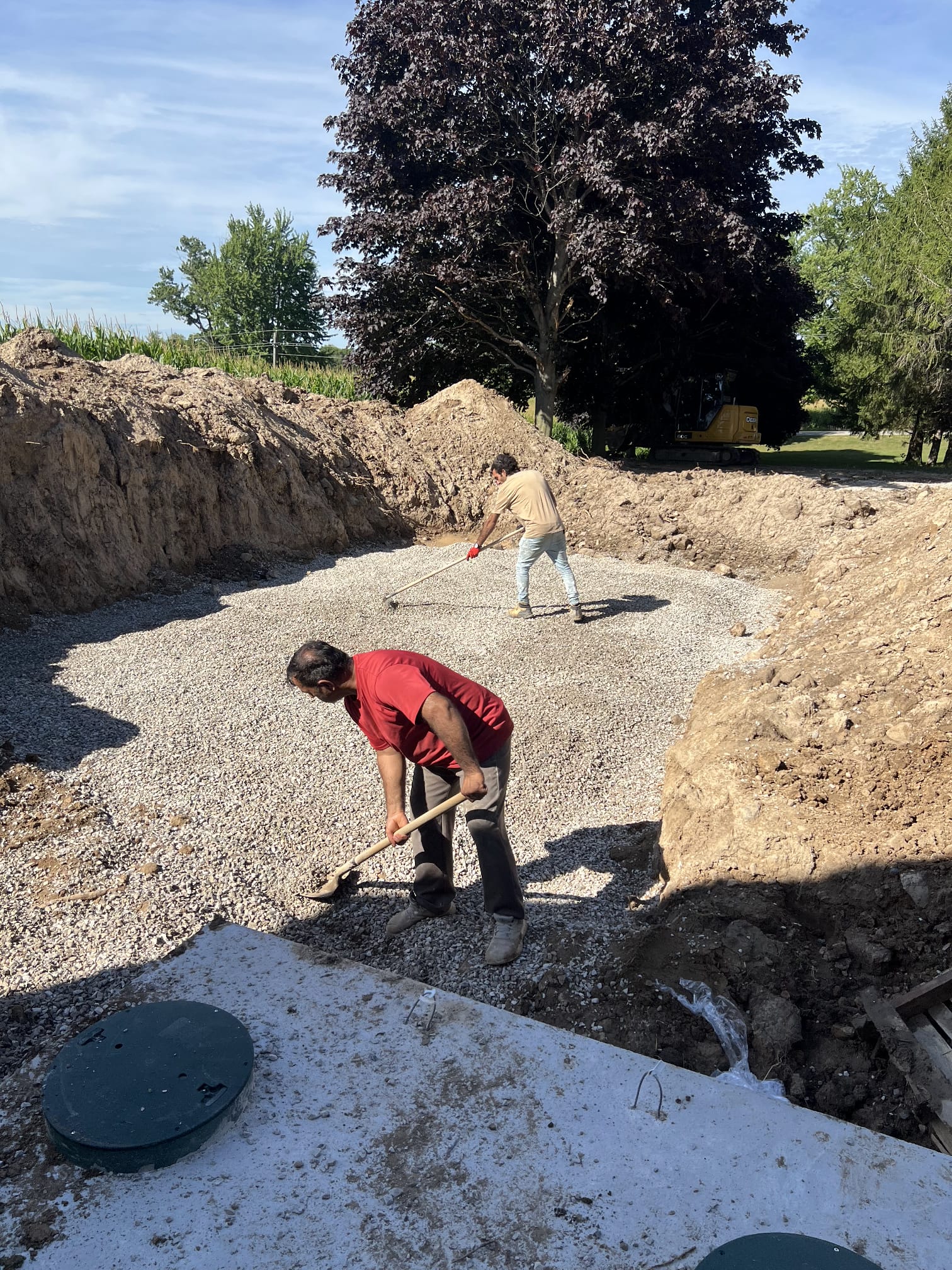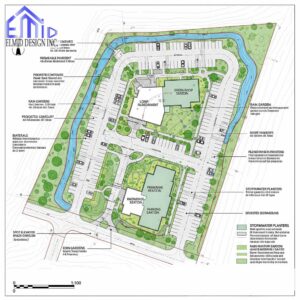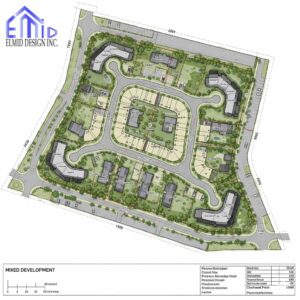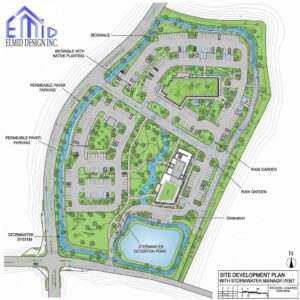Septic design Halton Hills plays an essential role in ensuring that wastewater from homes and buildings is treated and dispersed safely when municipal sewer services are not available. Halton Hills, known for its mix of rural and suburban properties, relies heavily on properly engineered septic systems to protect groundwater and maintain environmental safety. Every design must meet Ontario Building Code standards, considering soil type, groundwater level, and property layout. A well-designed system handles daily waste efficiently without polluting wells, rivers, or soil. Homeowners in Halton Hills benefit from working with licensed engineers such as Elmid Design Inc, an authorized firm under Professional Engineers Ontario. Their technical expertise and commitment to regulatory compliance ensure every project meets the highest standards for safety, durability, and environmental protection.
Understanding Septic Design in Halton Hills
Septic design Halton Hills involves creating a wastewater treatment system tailored to a property’s conditions. The process starts with assessing the soil and groundwater to determine how the site can safely manage effluent. The design must balance efficiency with environmental protection, ensuring that the treated water returns harmlessly to the ground. Properties in Halton Hills vary widely, from clay-rich farmland to hilly, rocky terrain, making local expertise critical. Engineers design each system according to specific site data, using calculations and code standards to establish tank size, bed location, and treatment method. A proper septic design ensures consistent system performance and long-term sustainability for both residential and commercial properties.
Regulatory Framework for Septic Systems in Halton Hills
All septic design Halton Hills projects must comply with the Ontario Building Code, Part 8, which governs small on-site sewage systems. These systems include septic tanks, distribution pipes, and leaching beds. The Halton Region Health Department manages permit approvals for septic systems in Halton Hills, ensuring designs meet environmental safety and public health requirements. Local regulations also include setbacks from wells, property boundaries, and watercourses to protect groundwater quality. Only licensed engineers or qualified designers are permitted to create and submit septic designs for approval. Compliance with these regulations guarantees system reliability, safety, and legal authorization for construction and operation.
Site Evaluation and Soil Testing in Halton Hills
Every septic design Halton Hills begins with a detailed site evaluation. Engineers analyze soil texture, composition, and permeability through tests such as percolation or “T-time” testing. This test measures how quickly water passes through the soil, which determines the type of septic system suitable for the site. Clay soils found in many areas of Halton Hills have slower drainage, requiring raised or tertiary systems. Sandy soils, by contrast, absorb water quickly but need careful design to prevent contamination. Engineers also consider slope, depth to groundwater, and seasonal variations. The data collected from these tests informs critical design decisions, ensuring the system functions safely and efficiently in local conditions.
Sizing the Septic System in Halton Hills
Accurate system sizing is one of the most important steps in septic design Halton Hills. Engineers calculate daily wastewater flow based on home size, number of bedrooms, and plumbing fixtures. The Ontario Building Code sets minimum tank capacities and bed sizes to handle these flows without overloading. Undersized systems can lead to backups or contamination, while oversized ones may increase costs unnecessarily. The engineer ensures the balance between capacity and efficiency by using precise measurements and soil data. Proper sizing also extends the system’s lifespan and reduces maintenance needs, making it a key factor in design success.
Types of Septic System Designs in Halton Hills
Several system types are used in septic design Halton Hills, depending on property size, soil type, and groundwater depth. Conventional gravity systems remain the most common option, relying on natural soil absorption for effluent treatment. However, properties with restrictive clay soils or high groundwater may require advanced systems such as raised beds or tertiary treatment units. These alternatives use engineered components like pumps, filters, and aerobic chambers to enhance treatment quality. Engineers select the right system type after analyzing field data, ensuring it meets both environmental standards and site-specific challenges unique to Halton Hills.
Engineering Oversight and Professional Expertise
Professional oversight ensures that septic design Halton Hills adheres to strict engineering and environmental standards. Firms such as Elmid Design Inc employ licensed engineers authorized by Professional Engineers Ontario, providing clients with certified and legally recognized designs. Engineering oversight guarantees that each stage—from site testing to final drawings—meets provincial codes and health regulations. It also ensures accountability, as licensed engineers must adhere to professional ethics and safety requirements. Their technical expertise reduces risk, prevents costly errors, and ensures the final septic system performs efficiently for decades. This level of professional involvement gives homeowners confidence and peace of mind.
Preparing Drawings and Documentation
The preparation of drawings and documentation forms a major part of septic design Halton Hills. Engineers create scaled site plans showing the location of the building, septic tank, distribution lines, and leaching bed. These drawings also indicate setback distances from wells, property boundaries, and surface water features. Elevations and grading details are included to verify that wastewater flows correctly through the system. Supporting documents such as soil reports, hydraulic calculations, and design summaries accompany the drawings for review. Precise documentation ensures the system’s design is transparent, compliant, and ready for municipal and health department approval.
The Permitting Process in Halton Hills
Obtaining a permit is a mandatory step for every septic design Halton Hills project. The application is submitted to the Halton Region Health Department, along with engineering drawings and reports. Inspectors review the documents to confirm that the design complies with all applicable codes and environmental standards. If the design meets the requirements, a permit is issued, authorizing construction. Incomplete or inaccurate submissions can delay approval or result in rejection. Working with professional engineers ensures the process runs smoothly, as they understand local regulations and maintain consistent communication with municipal authorities. Permit approval validates the design’s safety and compliance.
Installation and Construction Phases
Installation transforms septic design Halton Hills from blueprint to functioning system. Engineers provide guidance to ensure construction matches the approved plans precisely. Contractors must follow instructions regarding excavation depth, pipe placement, and tank positioning to maintain system efficiency. In areas with challenging soil or high groundwater, the construction team may install specialized drainage or filtration systems to enhance performance. Engineers typically perform site visits during installation to verify compliance. Strict adherence to the approved design prevents future issues such as leaks, backups, or environmental contamination. A well-supervised installation ensures a durable, efficient septic system.
Addressing Local Challenges in Halton Hills
Halton Hills presents unique challenges for septic design because of its diverse soil and terrain conditions. Areas with clay-based soils require advanced filtration and distribution systems to handle slow absorption rates. Properties located near conservation zones or watercourses must follow strict environmental protection standards. In regions with high groundwater levels, engineers design elevated systems that maintain proper separation from the water table. These site-specific challenges demand technical precision and local experience. Professional engineers adapt designs to meet these conditions while maintaining efficiency and regulatory compliance. Tailoring solutions to Halton Hills’ landscape ensures long-term performance and safety.
Environmental and Public Health Safeguards
Protecting public health and the environment is at the core of septic design Halton Hills. A well-designed system prevents untreated wastewater from entering groundwater or surface water sources. Engineers carefully calculate effluent loading rates and ensure soil filtration capacity is not exceeded. Compliance with the Ontario Building Code and regional health standards guarantees that systems are environmentally sound. Proper design safeguards drinking water supplies, preserves natural habitats, and prevents costly contamination events. These safeguards demonstrate the importance of professional engineering oversight and community responsibility in wastewater management across Halton Hills.
Why Professional Engineering Matters
Professional engineering makes a measurable difference in septic design Halton Hills. Licensed engineers provide not only technical precision but also legal accountability for every project. Their expertise ensures that systems are both code-compliant and environmentally responsible. Firms like Elmid Design Inc combine engineering knowledge with practical field experience, offering tailored solutions for every property. Their certification from Professional Engineers Ontario reinforces their authority and reliability. Using a professional engineer means that every component of the design has been analyzed, tested, and approved to perform safely under local conditions. This standard of excellence protects homeowners and the environment alike.
Benefits of Choosing Elmid Design Inc
Elmid Design Inc has become a trusted provider of septic design Halton Hills because of its dedication to engineering quality and environmental protection. The firm’s licensed engineers have in-depth knowledge of Ontario’s Building Code and regional regulations, ensuring that every project passes inspection without delay. Their hands-on approach includes field testing, design preparation, and permit coordination. Clients benefit from transparent communication and technical precision throughout each stage of the process. Elmid Design Inc’s commitment to sustainability and long-term reliability makes it a preferred choice for homeowners seeking efficient, durable, and regulation-compliant septic systems in Halton Hills.
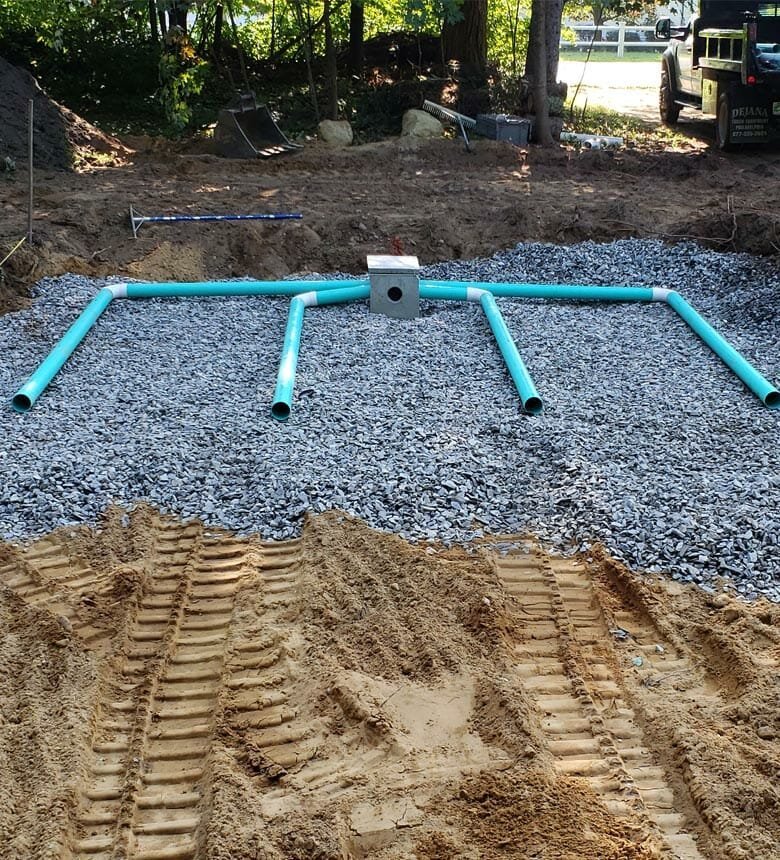
Drawing and Submission Process for Septic Design Halton Hills
The drawing and submission phase is the technical foundation of septic design Halton Hills. Engineers prepare scaled drawings that include every system component such as the septic tank, leaching bed, reserve area, and house footprint. These drawings are developed according to Ontario Building Code Part 8 and regional standards set by Halton Region. They must also show details like elevations, slopes, and separation distances from wells or property lines. Once completed, these plans are submitted for review to ensure compliance and environmental safety. The accuracy of this documentation determines how efficiently the design moves through the approval process. Professional engineers validate all dimensions and calculations before submission to prevent rejections or delays.
Permitting and Regulatory Review
Securing a permit for septic design Halton Hills is mandatory before any installation begins. The application process involves submitting engineered drawings, soil reports, and design summaries to the Halton Region Health Department. Officials review the design for compliance with local and provincial codes, focusing on groundwater protection and system capacity. The review process ensures that the design meets safety and environmental standards established under the Ontario Building Code. When the system is approved, the homeowner receives a permit authorizing construction. Working with licensed engineers simplifies this process because their familiarity with Halton Hills regulations reduces potential delays and ensures smooth approval.
Installation and Field Supervision
Installation is the most critical phase of septic design Halton Hills because it brings the engineered plan to life. Construction begins with excavation, tank placement, and installation of pipes and distribution components. The contractor must follow the approved design exactly to maintain efficiency and compliance. Engineers often visit the site during construction to verify alignment, slope, and tank elevation. Any deviation from the design can cause drainage problems or environmental contamination. Field supervision by engineers ensures all construction steps meet professional and legal standards. Once installation is complete, the system functions as intended and meets regulatory approval.
Inspection and Final Verification
After installation, the septic design Halton Hills must undergo inspection before being approved for use. Inspectors from the Halton Region Health Department visit the site to confirm that construction matches the approved drawings. They examine tank placement, leaching bed construction, pipe slopes, and soil compaction. The goal of this inspection is to ensure the system operates safely and protects groundwater. Engineers often assist during inspection to address any technical questions and confirm compliance with the Ontario Building Code. Passing this final review allows the homeowner to use the system confidently, knowing it meets both environmental and safety standards.
Maintenance and System Longevity
Proper maintenance is essential for the long-term success of septic design Halton Hills. Even the most advanced systems require regular inspection and cleaning to operate efficiently. Homeowners should schedule routine pump-outs to prevent solids from entering the leaching bed. Engineers often recommend maintenance intervals based on household size and system design. Seasonal variations in Halton Hills, such as rainfall and freezing temperatures, can affect system performance, so periodic monitoring helps prevent problems. Neglecting maintenance leads to early system failure and costly repairs. Consistent professional maintenance keeps the septic system effective and safeguards the property’s value for decades.
Cost Factors and Budget Planning
The overall cost of septic design Halton Hills depends on multiple factors such as soil conditions, lot size, and system type. Properties with poor drainage or high groundwater may require raised beds or advanced treatment systems, which increase material and design costs. Engineering fees, permit charges, and inspection costs also contribute to the total budget. Professional engineers help homeowners plan these expenses by providing detailed cost estimates before construction begins. Though initial costs may appear high, proper design prevents future issues and saves money over time. A well-planned septic system investment delivers safety, reliability, and long-term performance.
Common Mistakes to Avoid in Halton Hills
Homeowners often make critical mistakes during septic design Halton Hills projects when they overlook professional guidance. Using unqualified designers or skipping site testing can lead to non-compliance and permit rejection. Another common issue is choosing a system type unsuited to the property’s soil or groundwater level. Ignoring maintenance after installation also reduces efficiency and lifespan. Professional engineers prevent these errors through accurate testing, code compliance, and design verification. Their expertise ensures each system performs optimally under Halton Hills conditions. Avoiding these mistakes through proper engineering involvement protects both property owners and the environment.
Environmental Protection and Groundwater Safety
Groundwater protection is a core priority in septic design Halton Hills. Engineers design systems that maintain the required vertical separation between the leaching bed and groundwater. This separation ensures that effluent is filtered through soil layers before reaching the water table. When designs follow correct absorption rates and soil parameters, contamination risks are minimized. Engineers also consider local hydrogeological conditions to prevent system overload during heavy rainfall. These environmental safeguards are built into every professional design, ensuring wastewater is treated safely without harming surrounding water resources. Proper engineering helps maintain Halton Hills’ clean water supply for residents.
Technological Innovations in Septic Design
Modern technology is enhancing the effectiveness of septic design Halton Hills. Engineers now use advanced modeling software to predict effluent distribution and system performance under different soil and climate conditions. Digital monitoring tools allow early detection of issues such as blockages or tank overflow. Aerobic and tertiary treatment systems improve wastewater purification by breaking down contaminants more efficiently. These innovations support sustainability while meeting stricter environmental standards. Engineers integrate these technologies into their designs to ensure systems are more efficient, reliable, and environmentally friendly. As technology advances, septic systems in Halton Hills will continue to improve in performance and longevity.
Professional Oversight During Construction
Professional oversight during installation ensures that septic design Halton Hills is executed exactly as planned. Engineers monitor excavation depth, slope, and material use to verify compliance with design requirements. Their presence on-site helps prevent construction errors that could compromise performance. Oversight also ensures that contractors follow approved specifications for pipe alignment and leaching bed structure. Without professional supervision, even minor deviations can lead to system inefficiencies or environmental hazards. Engineers from authorized firms like Elmid Design Inc provide this level of supervision, ensuring that the final product meets both design integrity and provincial regulations.
Homeowner Responsibilities After Installation
Once a septic system is installed, homeowners in Halton Hills must take responsibility for its ongoing care. This includes scheduling regular inspections, monitoring water use, and ensuring no harmful chemicals enter the system. Engineers typically provide maintenance guidelines tailored to each design. Homeowners should keep accurate service records to demonstrate compliance with regional health requirements. Educated property owners play a vital role in maintaining system functionality. Adhering to these responsibilities ensures that the septic design Halton Hills continues to operate effectively and safely for many years, protecting both the property and the surrounding environment.
Role of Elmid Design Inc in Halton Hills
Elmid Design Inc has earned a reputation for excellence in septic design Halton Hills by delivering reliable, code-compliant, and environmentally responsible solutions. With a certificate of authorization from Professional Engineers Ontario, the firm ensures every design meets provincial and municipal standards. Their team combines technical precision with local experience, understanding the region’s complex soil and water conditions. Clients receive end-to-end support from site evaluation through design, permitting, and inspection. This commitment to quality, transparency, and sustainability makes Elmid Design Inc a trusted partner for property owners seeking efficient and durable septic systems in Halton Hills.
Sustainable Growth and Environmental Impact
Sustainable development is a growing focus in septic design Halton Hills. As the community expands, engineers prioritize systems that support responsible growth without harming natural ecosystems. Sustainable designs incorporate water conservation techniques and advanced treatment units that minimize environmental impact. Engineers ensure that every system aligns with regional development goals and environmental protection standards. These designs promote harmony between infrastructure growth and ecological balance. The professional application of sustainable engineering principles strengthens Halton Hills’ commitment to clean water, efficient land use, and long-term community health.
Future Trends in Septic System Design
The future of septic design Halton Hills lies in innovation and adaptability. Engineers are developing modular systems that allow for upgrades as environmental regulations evolve. Remote monitoring technology enables continuous system evaluation, improving performance and maintenance scheduling. Environmentally friendly materials and energy-efficient components are becoming more common in modern designs. Engineers continue to refine wastewater treatment methods to achieve higher purification levels and reduce carbon impact. These emerging trends position Halton Hills at the forefront of sustainable wastewater management, combining engineering excellence with environmental responsibility for years to come.
Advanced Engineering Techniques in Septic Design Halton Hills
Modern septic design Halton Hills incorporates advanced engineering techniques that ensure greater accuracy and long-term system performance. Engineers now use 3D modeling software and hydrogeological mapping to visualize soil absorption and groundwater flow before construction begins. This technology identifies potential drainage issues and allows for more precise system layouts. It also helps engineers optimize leaching bed placement, ensuring wastewater is treated effectively within the natural soil layer. These methods enhance safety, reduce environmental risk, and increase the lifespan of the system. By combining digital tools with professional expertise, engineering firms create septic solutions that align with both technical standards and environmental goals in Halton Hills.
Local Soil Adaptation and Site Conditions
The soil composition in Halton Hills varies greatly from site to site, making soil adaptation a critical part of the design process. Some areas have dense clay soils with poor drainage, while others contain sandy loam that drains too quickly. Engineers tailor each septic design Halton Hills to these variations, selecting system types that balance absorption and filtration. Clay soils often require raised beds or pressure distribution systems, whereas sandy soils benefit from controlled flow methods to prevent contamination. This level of adaptation ensures every design performs efficiently within the region’s complex geological conditions, maintaining compliance and environmental safety.
Managing Groundwater and Drainage Challenges
Groundwater management plays a vital role in septic design Halton Hills. Engineers assess groundwater levels through field testing to maintain the required separation distance between the leaching bed and the water table. In areas where the water table is high, elevated or tertiary systems are designed to prevent effluent from reaching groundwater sources. Drainage management is also important because improper slope or water pooling can lead to system overload. Engineers incorporate drainage controls such as grading adjustments and contour mapping to protect the septic system. These strategies ensure long-term stability, environmental protection, and consistent wastewater treatment across Halton Hills properties.
Integration of Sustainable Wastewater Technologies
Sustainability is a cornerstone of modern septic design Halton Hills. Engineers increasingly incorporate technologies that enhance treatment efficiency while minimizing environmental impact. Aerobic treatment units, biofilters, and advanced tertiary systems remove contaminants before effluent reaches the soil. These systems use natural or mechanical aeration to promote bacterial breakdown, resulting in cleaner wastewater. Sustainable septic designs reduce chemical usage and energy consumption, aligning with Ontario’s environmental policies. By integrating green technologies, engineers support eco-friendly development in Halton Hills while ensuring every property meets regulatory and performance expectations for long-term wastewater safety.
The Role of Regular Inspections in System Efficiency
Routine inspections are crucial for maintaining the functionality of septic design Halton Hills. Engineers recommend regular checkups to monitor effluent levels, flow rates, and tank integrity. Inspections identify early warning signs such as blockages, leaks, or poor drainage, preventing costly repairs. Professional evaluations also ensure continued compliance with local regulations. Engineers use advanced diagnostic tools to assess system efficiency and confirm that soil absorption remains consistent. Regular inspections extend the system’s lifespan and maintain groundwater protection, ensuring homeowners enjoy reliable wastewater management for decades without environmental or operational issues.
Importance of Licensed Engineers in Design Approval
Design approval depends heavily on professional credentials and expertise. Licensed engineers oversee septic design Halton Hills to ensure every component meets code requirements and environmental safety standards. These professionals are authorized by Professional Engineers Ontario, guaranteeing their accountability and technical competence. Their involvement ensures accuracy in calculations, documentation, and soil analysis. Engineers like those at Elmid Design Inc take full responsibility for each project, providing clients with peace of mind that their system is safe and compliant. This level of professional oversight is essential for regulatory approval and successful long-term performance of the septic system.
Training and Certification in Septic Engineering
Septic design Halton Hills requires not only engineering knowledge but also specialized training and certification. Engineers and designers must stay current with updates to the Ontario Building Code and advancements in wastewater technology. Continuing education and professional development ensure designs remain compliant with evolving standards. Firms like Elmid Design Inc invest in ongoing training for their staff, allowing them to apply the latest methods in soil testing, modeling, and sustainable design. This commitment to education strengthens both technical accuracy and environmental stewardship, ensuring homeowners receive the highest quality engineering services.
Innovation and Research in Wastewater Management
Continuous research drives improvement in septic design Halton Hills. Engineers collaborate with environmental scientists to develop more efficient and sustainable wastewater treatment methods. Studies on soil behavior, effluent dispersion, and nutrient removal guide new design standards. These innovations reduce environmental impact while enhancing system efficiency. Advanced research also promotes the use of renewable materials and smart monitoring technologies that make systems easier to manage. Engineering firms apply these findings to real-world projects, demonstrating a commitment to both scientific advancement and community well-being. Ongoing innovation keeps Halton Hills at the forefront of sustainable wastewater engineering in Ontario.
Homeowner Education and System Care
Educating homeowners is essential for the long-term success of septic design Halton Hills. Engineers emphasize the importance of responsible usage, such as avoiding chemical disposal and managing water consumption. Understanding how the system functions helps property owners identify early warning signs of malfunction. Homeowners are encouraged to maintain service records and schedule regular professional inspections. This partnership between engineers and property owners ensures that each system operates at full efficiency. Education not only protects individual investments but also supports the wider goal of environmental preservation within the Halton Hills community.
Role of Elmid Design Inc in Professional Engineering
Elmid Design Inc stands as a trusted provider of septic design Halton Hills, known for its professionalism, regulatory expertise, and technical precision. The company holds a certificate of authorization from Professional Engineers Ontario, ensuring that all designs meet legal and ethical standards. Their engineers combine field experience with advanced technology to create efficient and sustainable wastewater systems. Clients benefit from detailed analysis, clear communication, and complete support from testing to final approval. Elmid Design Inc’s dedication to engineering excellence and environmental responsibility continues to make it a leader in septic system design across Ontario.
Sustainable Development in Halton Hills
Sustainable growth in Halton Hills depends on proper wastewater management and environmentally conscious design. Engineers plan septic systems that support urban expansion without harming natural resources. By implementing low-impact technologies and efficient water reuse strategies, they help balance development with conservation. Sustainable septic design Halton Hills contributes to cleaner groundwater, reduced pollution, and long-term community resilience. Each professionally engineered system reflects a commitment to responsible growth and the preservation of Halton Hills’ rural character. Engineering expertise ensures that modern infrastructure can coexist harmoniously with the area’s environmental priorities.
Technological Future of Septic Systems
The future of septic design Halton Hills is moving toward automation and intelligent monitoring. Engineers are developing systems that can transmit real-time data on flow rates, tank levels, and maintenance needs. Artificial intelligence and remote sensing technologies will soon help detect performance issues before they become critical. These innovations will reduce maintenance costs and improve efficiency. As regulations evolve, engineers will continue integrating smarter and greener designs into new developments. This forward-thinking approach ensures that Halton Hills remains aligned with provincial goals for sustainable infrastructure and clean water protection for generations to come.
Frequently Asked Questions
Who can design septic systems in Halton Hills?
Only licensed professional engineers or registered designers with Building Code Identification Numbers are authorized to create and submit septic designs in Ontario.
How long does a septic system last in Halton Hills?
With proper design, installation, and regular maintenance, a septic system can last between twenty and thirty years depending on soil conditions and usage.
What permits are needed for septic design Halton Hills?
All new or replacement septic systems require approval under the Ontario Building Code Part 8. The Halton Region Health Department reviews and issues these permits.
What is the most common cause of septic failure?
Failure usually occurs due to poor design, lack of maintenance, or overloading the system with excessive water or harsh chemicals.
Why choose Elmid Design Inc for septic design Halton Hills?
Elmid Design Inc provides licensed engineering services backed by Professional Engineers Ontario certification. Their designs combine local expertise, regulatory compliance, and sustainable engineering to ensure reliable wastewater management.

Leading Engineering Experts Serving Ontario
Elmid Design Inc is a licensed engineering firm recognized for delivering precise, regulation-compliant septic design Halton Hills and other civil engineering solutions across Ontario. With authorization from Professional Engineers Ontario, the company upholds the highest professional and ethical standards in every project. Its experienced engineers combine technical expertise, advanced design tools, and local knowledge to create safe, efficient, and sustainable wastewater systems. Homeowners and developers trust Elmid Design Inc for dependable engineering services that protect the environment, ensure compliance, and enhance long-term property value through expert design and professional integrity.
Geographic Locations That We Service:
Our Licensed Professional Engineers specializing in Engineered Site Grading Plans offer the best-engineered site grading plan, lot grading and erosion plan, and drainage plan to obtain site plan approval and building permits in Ontario, including a wide range of municipalities. Each area boasts unique features and requirements, making our tailored approach essential for success.
Toronto and Surrounding Areas
In the vibrant heart of Ontario, we service Toronto (City of Toronto) and surrounding areas. Additionally, we cover Oshawa (City of Oshawa), Pickering (City of Pickering), and Clarington (Municipality of Clarington). Furthermore, our expertise extends to Ajax (Town of Ajax), Whitby (Town of Whitby), Brock (Township of Brock), Scugog (Township of Scugog and Uxbridge (Township of Uxbridge).
Halton Region
Moving to the Halton Region, our services encompass Burlington (City of Burlington) and Halton Hills (Town of Halton Hills). Also included are Milton (Town of Milton) and Oakville (Town of Oakville).
Peel Region
In the Peel Region, we provide services in Brampton (City of Brampton), Mississauga (City of Mississauga), and Caledon (Town of Caledon).
York Region
Our services in the York Region cover Vaughan (City of Vaughan), Aurora (Town of Aurora), and East Gwillimbury (Town of East Gwillimbury). We also cater to Georgina (Town of Georgina), Markham (City of Markham), Newmarket (Town of Newmarket), Richmond Hill (City of Richmond Hill), Whitchurch-Stouffville (Town of Whitchurch-Stouffville), King (Township of King), and Bradford-West Gwillimbury (Town of Bradford-West Gwillimbury). Each municipality here offers a distinct setting, requiring our specialized approach.
Other Southern Ontario Cities and Towns
We also serve many other cities and towns in Southern Ontario. These include Hamilton (City of Hamilton), St. Catharines (City of St. Catharines), Niagara on the Lake (Town of Niagara on the Lake), Brant (County of Brant), Cambridge (City of Cambridge), Kitchener (City of Kitchener), Waterloo (City of Waterloo), and Woodstock (City of Woodstock). Furthermore, we operate in Guelph (City of Guelph), Centre Wellington (Township of Centre Wellington), Shelburne (Town of Shelburne), Orangeville (Town of Orangeville), New Tecumseth (Town of New Tecumseth), Essa (Town of Essa), Collingwood (Town of Collingwood), Wasaga Beach (Town of Wasaga Beach), Barrie (City of Barrie), Midland (Town of Midland), Orillia (City of Orillia), Ramara (Town of Ramara), Minden Hills (Town of Minden Hills), North Kawartha (Town of North Kawartha), Kawartha Lakes (City of Kawartha Lakes), Peterborough (City of Peterborough), Selwyn (Town of Selwyn), and Brighton (Municipality of Brighton).

